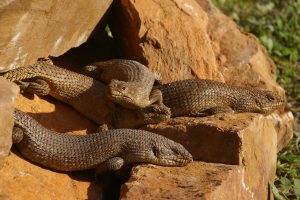Some lizards and snakes tend to hang out in family groups, not unlike the more familiar social groups of birds and mammals. Our recent study, headed by Ben Halliwell and Geoff While and published in Nature Communications, show that the evolution of social grouping is much more likely to have happened in lizards and snakes that give birth to live young. There could be a number of reasons that transitions to sociality are more common for live bearing species.
The most obvious one – and the theoretical rationale behind this study – is that giving birth to live young makes interactions between parents and offspring more likely than in species that lay eggs. And interaction among kin, in turn, is what causes natural selection for group living.
Some lizards – in particular the Egernia – in fact have quite complex kin-based social structures. As expected, such groups have almost exclusively evolved in live-bearing lineages. Interestingly, egg guarding does not seem to have the same positive effect on the evolution of sociality. Maybe this is because the ecology needs to be right as well to select for delayed dispersal and parental tolerance of offspring. For the full story, please download the paper here.

